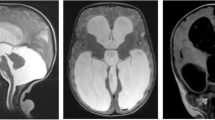Abstract
Purpose
Congenital hydrocephalus (CH) has higher proportions in developing countries such as Brazil, reaching rates of 3.16:1,000 newborns. Early diagnosis is essential and can be done during the second trimester of pregnancy, highlighting the importance of regular prenatal care. Our objective is to describe the epidemiological profile of children with CH in the state of Bahia.
Methods
Consecutive medical records of patients with CH, aged less than 2years and operated at a pediatric reference hospital between September 2009 and September 2012, were reviewed.
Results
One hundred twenty-one children underwent ventricular peritoneal shunt (VP shunt) due to CH. As for prenatal care, 38 % of pregnant women did it regularly. Males predominated with 56 % of cases with a median age of 3 months, and 68 % were from the countryside area. The most frequent clinical manifestations were bulging fontanelle (37 %) and increased head circumference (30 %). There were 13 (11 %) reports of complications associated with VP shunts. There were nine deaths (7 %), and respiratory complications were the main cause.
Conclusions
Public health measures are the key to increase mothers’ knowledge about the importance of regular prenatal monitoring. There was a predominance of male children, with a median age of 3 months, with the majority coming from the countryside.
Similar content being viewed by others
References
Brazilian Institute of Geography and Statistics (2013) 2010 population census. In: Brazilian Institute of Geography and Statistics population census. http://www.ibge.gov.br/estadosat/perfil. Accessed 04 Jan 2013
Brazilian Ministry of Health (2006) Prenatal and puerperal. Humanized and qualified care. Technical manual. Book no. 5, Ministry of Health. http://portal.saude.gov.br/portal/arquivos/pdf/manual_puerperio_2006.pdf. Accessed 04 Jan 2013
Cavalcanti DP, Salomão MA (2003) Incidence of congenital hydrocephalus and the role of the prenatal diagnosis. J Pediatr 79(2):135–140. doi:10.1590/s0021-75572003000200008
Cavalheiro S, Moron AF, Almodin CG, Suriano IC, Hisaba V, Dastoli P, Barbosa M (2001) Fetal hydrocephalus. Child’s Nerv Syst 27(10):1575–1583. doi:10.1007/s00381-011-1539-1
Choux M (1994) Consensus: treatment. Child’s Nerv Syst 10:74–75. doi:10.1007//BF00313589
Cinalli G, Spennato P, Nastro A, Aliberti F, Trishitta V, Ruggiero C, Mirone G, Cianciulli E (2011) Hydrocephalus in aqueductal stenosis. Child’s Nerv Syst 27:1621–1642. doi:10.1007/s00381-011-1546-2
Cochrane DD, Myles ST (1982) Management of intrauterine hydrocephalus. J Neurosurgery 57(5):590–596
de Wals P, Tairou F, Van Allen M, Uh SH, Lowry RB, Sibbald B, Evans JA, Van den Hof MC, Zimmer P, Crowley M, Fernandez B, Lee NS, Niyonsenga T (2007) Reduction in neural-tube defects after acid fortification in Canada. N Engl J Med 357:135–142. doi:10.1056/NEJMoa067103
Di Rocco F, Luedemenn W, Oi S (2009) Complications of neuroendoscopy. Journal of Hydrocephalus 1(1):15–20
Gorayeb RP, Cavalheiro S, Zymberg ST (2004) Endoscopic third ventriculostomy in children younger than 1 year of age. J Neurosurgery 100(Suppl Pediatrics):427–429
Hommelstad J, Madso A, Eide PK (2013) Significant reduction of shunt infection rate in children below 1 year of age after implementation of a perioperative protocol. Acta Neurochir 155:523–531. doi:10.1007/s00701-012-1574-z./26
Juca CEB, Lins Neto A, de Oliveira RS, Machado HR (2002) Treatment of hydrocephalus by ventriculoperitoneal shunt: analysis of 150 consecutive cases in the Hospital of the Faculty of Medicina of Ribeirão Preto. Acta Cirurgica Brasileira 70(2):59–63
Koch D, Wagner W (2004) Endoscopic third ventriculostomy in infants of less than 1 year of age: which factors influence the outcome? Child’s Nerv Syst 20(6):405–411. doi:10.1007/s00381-004-0958-7
Kumar R, Singh V, Kumar MVK (2005) Shunt revision in hydrocephalus. Indian J Pediatr 72:843–847
Lumenta CB, Skotarczak U (1995) Long-term follow-up in 233 patients with congenital hydrocephalus. Child’s Nerv Syst 11:173–175
Massimi L, Paternoster G, Fasano T, Di Rocco C (2009) On the changing epidemiology of hydrocephalus. Child’s Nerv Syst 25:795–800. doi:10.1007/s00381-009-0844-4
Nomura ML, Barini R, Andrade KC, Milanez H, Simoni RZ, Peralta CFA, Machado IN, Zambelli H, Maio KT (2010) Congenital hydrocephalus: gestational and neonatal outcomes. Arch Gynecol Obstet 282:607–611. doi:10.1007/s00404-009-1254-2
Oi S, Inagaki T, Shinoda M, Takahashi S, Ono S, Date I, Nomura S, Miwa T, Araki T, Ito S, Uchikado H, Takemoto O, Shirane R, Nishimoto H, Tashiro Y, Matsumara A (2011) Guideline for management and treatment of fetal and congenital hydrocephalus: Center of Excellence-Fetal and Congenital Hydrocephalus Top 10 Japan Guideline 2011. Child’s Nerv Syst 27(10):1563–1570. doi:10.1007/s00381-011-1541-7
Oliveira DMP, Pereira CU, Freitas ZMP (2011) Socio-economic profile of caregivers of children with hydrocephalus. Arq Bras Neurocir 30(3):94–98
Oliveira DMP, Pereira CU, Freitas ZMP (2010) Knowledge of caregivers of children with hydrocephalus. Rev Bras Enferm 63(5):782–785. doi:10.1590/s0034-71672010000500014./10
Pretorius DM, Davis K, Manco-Johnson ML, Manchester D, Meier PR, Clewell WH (1985) Clinical course of fetal hydrocephalus: 40 cases. American Journal of Roentgen (AJR) 144:827–831
Rekate H (2011) A Consensus on the classification of hydrocephalus: it’s utility in the assessment of abnormalities of cerebrospinal fluid dynamics. Child’s Nerv Syst 27:535–1541. doi:10.1007/s00381-011-1558-y
Renier D, Sainte-Rose C, Pierre-Khan A, Hirsh JF (1988) Prenatal hydrocephalus: outcome and prognosis. Child’s Nerv Syst 4:213–222
Sgourus S, Kulkharni AV, Constantini S (2006) The international infant hydrocephalus study: concept and rational. Child’s Nerv Syst 22:338–345. doi:10.1007/s00381-005-1253-y
Tuli S, Tuli J, Drake J, Spears J (2004) Predictors of death in pediatric patients requiring cerebrospinal fluid shunts. J Neurosurg 100(Pediatrics 5):442–446
Zahl SM, Wester K (2008) Routine measurement of head circumference as a tool for detecting intracranial expansion in infants: what is the gain? A nationwide survey. Pediatrics 21(3):416–420. doi:10.1542/peds.2007-1598
Conflict of interest
The authors declare that they have no conflict of interest.
Author information
Authors and Affiliations
Corresponding author
Rights and permissions
About this article
Cite this article
Melo, J.R.T., de Melo, E.N., de Vasconcellos, Â.G. et al. Congenital hydrocephalus in the northeast of Brazil: epidemiological aspects, prenatal diagnosis, and treatment. Childs Nerv Syst 29, 1899–1903 (2013). https://doi.org/10.1007/s00381-013-2111-y
Received:
Accepted:
Published:
Issue Date:
DOI: https://doi.org/10.1007/s00381-013-2111-y




